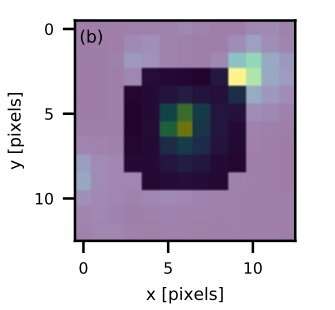A 13-by-13 pixel cutout of a TESS full frame image of J0500−0930, with the aperture used by eleanor indicated as the darker region. Credit: Kawka et al., 2020.
A team of astronomers from Australia and Italy has investigated a nearby white dwarf designated 2MASS J050051.85–093054.9 (J0500−0930 for short). In their new study, they report that the object is the closest extremely low-mass white dwarf. The finding is detailed in a paper published April 16 on arXiv.org.
Extremely low-mass (ELM) white dwarfs (WDs) are very rare objects, found with only few exceptions in short-period binaries. In ELM WD binaries, one of the stars has a mass lower than 0.3 solar masses. It is assumed that such a low mass cannot be a result of canonical single-star evolution; therefore, these systems are thought to undergo significant mass loss during their evolution.
To date, only about 100 ELM WDs are known, so finding new ones and studying them in detail could be essential to advance knowledge of stellar evolution. Some systems of this type are also predicted to emit gravitational waves, and could hence shed more light on the nature of this phenomenon.
Located some 233 light years away, J0500−0930 is a WD with an effective temperature of about 11,900 K. Previous studies have suggested that it may be an ELM WD, and the study now presented by a group of astronomers led by Adela Kawka of Curtin University in Perth, Australia, confirms this assumption. The new study is based on follow-up observations of J0500−0930 with the ANU 2.3-m telescope at Siding Spring Observatory and on the analysis of data from NASA's Transiting Exoplanet Survey Satellite (TESS).
"In this work, we present a detailed analysis of 2MASS J05005185−0930549, which confirms a suggestion offered by Scholz et al. (2018), later seconded by Pelisoli & Vos (2019), that J0500−0930 is an ELM WD," the paper reads.
The study found that J0500−0930 has a mass of about 0.17 solar masses and effective temperature at a level of approximately 10,500 K. Moreover, the results suggest that this star is part of a short-period, post-interacting double degenerate system with an unseen white dwarf companion.
The authors of the paper revealed that J0500−0930 is on a disk-like orbit with an eccentricity of about 0.27. The orbital period of the system was measured to be approximately 9.5 hours.
When it comes to the unseen companion of J0500−0930, the astronomers estimate that it must have a mass of at least 0.3 solar masses. In general, the results indicate that the companion is a WD fainter than J0500−0930, with a higher mass and lower effective temperature.
It turns out that J0500−0930 is currently the closest ELM WD to our planet. The second closest one is GALEX J1717+6757, found some 580 light years away.
Pondering the fate of the system, the astronomers concluded that J0500−0930 will merge with its companion in at least few tens of billion years, most likely through unstable mass transfer.
More information: The closest extremely low-mass white dwarf to the Sun, arXiv:2004.07556 [astro-ph.SR] arxiv.org/abs/2004.07556
© 2020 Science X Network
























